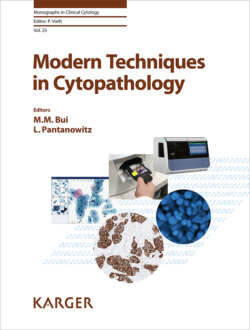Читать книгу Modern Techniques in Cytopathology - Группа авторов - Страница 30
На сайте Литреса книга снята с продажи.
Cell Blocks: Application to Modern and Alternative Techniques
ОглавлениеCell blocks have several advantages, some described more extensively in the literature and others gaining recognition. For instance, cell blocks allow cytology samples to be utilized diagnostically in ways that have traditionally been reserved for surgical pathology specimens. Digital pathology is one such rapidly growing field. Whole-slide imaging (WSI) of surgical pathology slides, which have 2-dimensions in the x and y planes, provide high-resolution images from an entire scanned slide. The Food and Drug Administration (FDA) approved the marketing of a WSI system, Philips IntelliSite Pathology Solutions (PIPS), for reviewing and interpreting FFPE surgical pathology slides for diagnostic use. Cytology specimens were specifically excluded from this approval. Cytology LBC preparations and smears, unlike surgical pathology specimens, have 3 dimensions in the x, y, and z planes. Thus, with conventional light microscopy subtle focus adjustments of the stage are required to bring cells located in different planes into focus. The added z-axis of WSI scanning requires greater slide scanning time and storage of larger files [37], and this limitation prevents the routine use of most commercial WSI systems for cytology practice. However, cell block slides (akin to “tissue sections”) by converging cytology and histology, are 2-dimensional and thus could offer an alternative for WSI of cytology material. Indeed, Tawfik et al. [37] have described the use of WSI on cell blocks prepared from residual gynecological Pap samples. Based on 1,110 Pap test slides prepared and analyzed using WSI, the sensitivity reported by these authors was comparable to standard LBC-prepared slides and highly specific for identifying low-grade intraepithelial lesions and high-grade squamous intraepithelial lesions. Given that cell blocks are somewhat comparable to surgical pathology specimens, they may have potential for WSI diagnostic use.
Tissue microarrays (TMAs), a high-throughput, faster, and more economical method for comparative IHC or molecular analyses, are generally derived from surgical pathology specimens. They are constructed by removing cylindrical cores of tissue from separate “donor” FFPE blocks, which are then assembled together in a single “recipient” paraffin block. Since cytology microarrays [38] have been constructed largely from cells, they may not afford the same advantages associated with TMAs derived from FFPE blocks. With adequately cellular cell blocks, however, there is an opportunity to create cytology-derived FFPE TMAs [39] and accordingly perform high-throughput analyses on cytology specimens, which may sometimes represent the only sample available from patients.
Clinicians and cytologists are sometimes faced with cytology samples that are non-diagnostic or inadequate for ancillary testing, which hinders appropriate patient management. This may result from various factors, including the nature of the lesion targeted for FNA, operator skill, and inadequate cellularity on the cell block. To improve the diagnostic yield, manufacturers of needles, especially for endoscopic ultrasound-guided procedures, have developed larger-gauge needles with new needle tip designs that extract “micro-cores.” The procedure and sample represent a hybrid – the motion to obtain the tissue fragments is the same as FNA biopsies, yet the needle size and design produce a “micro-core.” These samples typically contain mini tissue fragments in a core-shaped fragment of partially clotted blood. These FNA-derived micro-core biopsies represent a cross-roads between cytology and histology. There is some debate regarding the best method and laboratory ideally equipped to manage such specimens – either as cytology cell blocks or as histology biopsies. Since these samples, in addition to having visible tissue fragments, also contain cells dispersed in blood and liquid media, they are better managed by cytology procedures that will capture all of the cells by centrifugation and then allow them to be processed as a cell block. The larger fragments that can be easily handled with forceps can be placed directly into a cassette in a manner similar to grossing core biopsies or combined in the cell block. In cases where two blocks are created, one using centrifugation and the other without centrifugation, they are still best handled by the same (cytology) laboratory and assigned the same laboratory accessioning number to avoid discrepant reporting and redundant ancillary testing. Unfortunately, there is no standardized protocol to manage these newer specimens. With suboptimal management of such specimens and lack of communication concerning the added value of capturing more cells within a cell block, cytology risks losing these specimens to surgical pathology, which may result in loss of the important background cellular component of the sample, inferior quality of the final product, and thus substandard quality of the final diagnosis and patient care.
